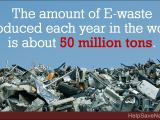
Copper & technology are great partners, but what we do with all those old gadgets-and the copper in them-is a tough challenge. Till now.
In fact Australia is at the cutting edge of what’s being called urban mining.
New breakthroughs in Sydney & Melbourne suggest we could now harvest copper-and a lot of other valuable stuff-from things like old smartphones or computers and make it pay. A viable e-waste industry in other words.
It can’t come too soon. Over 40M tonnes of e-waste is generated worldwide every year- Australia adds about 100,000 tonnes of that-and with no let up in sight.
Most of it ends up being landfilled, stored or incinerated. And as the UN recently pointed out, a lot of it can also end up at rudimentary recycling sites in developing countries despite few environmental, employment and operational safeguards to deal with any hazardous chemicals properly.
Things are changing though and I’m glad to say Australia is helping.
Recently the University of NSW launched the worlds first e-waste ‘microfactory’ to cost effectively transform old technology into useful products like copper, while glass and plastic from gadgets can be converted into micromaterials.
The UNSW is rapidly forming partnerships with industry and government to make the microfactory technology more widely available. A boon for rural & remote areas where dealing with e-waste is prohibitively expensive.
The other breakthrough has been at Swinburne Institute of Technology in Melbourne which found Australia could profitably set up facilities to handle 30,000 tonnes of e-waste a year.
In Melbourne, for example, that could process all the e-waste associated with Victoria and Tasmania. And with better collection get processing rates above 30,000 tonnes.
Both breakthroughs rely on the high commercial value of recycled copper to make them cost effective. And in a world where copper is essential to our insatiable demand for technology that sounds like a real virtuous cycle to me.